*NURSING > NCLEX-RN > NCLEX-RN Nursing Fundamentals Study Guide, Questions and Answers A+ WORK. (All)
NCLEX-RN Nursing Fundamentals Study Guide, Questions and Answers A+ WORK.
Document Content and Description Below
NCLEX NCLEX-RN QUESTION 1 Which classification of drugs is contraindicated for the client with hypertrophic cardiomyopathy? A. Positive inotropes B. Vasodilators C. Diuretics D. Antidysrhythmics ... Answer: A Explanation: (A) Positive inotropic agents should not be administered owing to their action of increasing myocardial contractility. Increased ventricular contractility would increase outflow tract obstruction in the client with hypertrophic cardiomyopathy. (B) Vasodilators are not typically prescribed but are not contraindicated. (C) Diuretics are used with caution to avoid causing hypovolemi A. (D) Antidysrhythmics are typically needed to treat both atrial and ventricular dysrhythmias. QUESTION 2 Signs and symptoms of an allergy attack include which of the following? A. Wheezing on inspiration B. Increased respiratory rate C. Circumoral cyanosis D. Prolonged expiration Answer: D Explanation: (A) Wheezing occurs during expiration when air movement is impaired because of constricted edematous bronchial lumin A. (B) Respirations are difficult, but the rate is frequently normal. (C) The circumoral area is usually pale. Cyanosis is not an early sign of hypoxi A. (D) Expiration is prolonged because the alveoli are greatly distended and air trapping occurs. QUESTION 3 A client confides to the nurse that he tasted poison in his evening meal. This would be an example of what type of hallucination? A. Auditory B. Gustatory C. Olfactory D. Visceral Answer: B Explanation: (A) Auditory hallucinations involve sensory perceptions of hearing. (B) Gustatory hallucinations involve sensory perceptions of taste. (C) Olfactory hallucinations involve sensory perceptions of smell. (D) Visceral hallucinations involve sensory perceptions of sensation. NCLEX NCLEX-RN QUESTION 4 Which of the following findings would be abnormal in a postpartal woman? A. Chills shortly after delivery B. Pulse rate of 60 bpm in morning on first postdelivery day C. Urinary output of 3000 mL on the second day after delivery D. An oral temperature of 101F (38.3C) on the third day after delivery Answer: D Explanation: (A) Frequently the mother experiences a shaking chill immediately after delivery, which is related to a nervous response or to vasomotor changes. If not followed by a fever, it is clinically innocuous. (B) The pulse rate during the immediate postpartal period may be low but presents no cause for alarm. The body attempts to adapt to the decreased pressures intra-abdominally as well as from the reduction of blood flow to the vascular bed. (C) Urinary output increases during the early postpartal period (12–24 hours) owing to diuresis. The kidneys must eliminate an estimated 2000–3000 mL of extracellular fluid associated with a normal pregnancy. (D) A temperature of 100.4F (38C) may occur after delivery as a result of exertion and dehydration of labor. However, any temperature greater than 100.4F needs further investigation to identify any infectious process. QUESTION 5 A six-month-old infant has been admitted to the emergency room with febrile seizures. In the teaching of the parents, the nurse states that: A. Sustained temperature elevation over 103F is generally related to febrile seizures B. Febrile seizures do not usually recur C. There is little risk of neurological deficit and mental retardation as sequelae to febrile seizures D. Febrile seizures are associated with diseases of the central nervous system Answer: C Explanation: (A) The temperature elevation related to febrile seizures generally exceeds 101F, and seizures occur during the temperature rise rather than after a prolonged elevation. (B) Febrile seizures may recur and are more likely to do so when the first seizure occurs in the 1st year of life. (C) There is little risk of neurological deficit, mental retardation, or altered behavior secondary to febrile seizures. (D) Febrile seizures are associated with disease of the central nervous system. QUESTION 6 A client diagnosed with bipolar disorder continues to be hyperactive and to lose weight. Which of the following nutritional interventions would be most therapeutic for him at this time? A. Small, frequent feedings of foods that can be carried B. Tube feedings with nutritional supplements C. Allowing him to eat when and what he wants D. Giving him a quiet place where he can sit down to eat meals Answer: A Explanation: (A) The manic client is unable to sit still long enough to eat an adequate meal. Small, frequent feedings with NCLEX NCLEX-RN finger foods allow him to eat during periods of activity. (B) This type of therapy should be implemented when other methods have been exhausted. (C) The manic client should not be in control of his treatment plan. This type of client may forget to eat. (D) The manic client is unable to sit down to eat full meals. QUESTION 7 A client with bipolar disorder taking lithium tells the nurse that he has ringing in his ears, blurred vision, and diarrhe A. The nurse notices a slight tremor in his left hand and a slurring pattern to his speech. Which of the following actions by the nurse is appropriate? A. Administer a stat dose of lithium as necessary. B. Recognize this as an expected response to lithium. C. Request an order for a stat blood lithium level. D. Give an oral dose of lithium antidote. Answer: C Explanation: (A) These symptoms are indicative of lithium toxicity. A stat dose of lithium could be fatal. (B) These are toxic effects of lithium therapy. (C) The client is exhibiting symptoms of lithium toxicity, which may be validated by lab studies. (D) There is no known lithium antidote. QUESTION 8 A diagnosis of hepatitis C is confirmed by a male client’s physician. The nurse should be knowledgeable of the differences between hepatitis A, B, and C. Which of the following are characteristics of hepatitis C? A. The potential for chronic liver disease is minimal. B. The onset of symptoms is abrupt. C. The incubation period is 2–26 weeks. D. There is an effective vaccine for hepatitis B, but not for hepatitis C. Answer: C Explanation: (A) Hepatitis C and B may result in chronic liver disease. Hepatitis A has a low potential for chronic liver disease. (B) Hepatitis C and B have insidious onsets. Hepatitis A has an abrupt onset. (C) Incubation periods are as follows: hepatitis C is 2–26 weeks, hepatitis B is 6–20 weeks, and hepatitis A is 2–6 weeks. (D) Only hepatitis B has an effective vaccine. QUESTION 9 Hypoxia is the primary problem related to near-drowning victims. The first organ that sustains irreversible damage after submersion in water is the: A. Kidney (urinary system) B. Brain (nervous system) C. Heart (circulatory system) D. Lungs (respiratory system) Answer: B Explanation: NCLEX NCLEX-RN (A) The kidney can survive after 30 minutes of water submersion. (B) The cerebral neurons sustain irreversible damage after 4–6 minutes of water submersion. (C) The heart can survive up to 30 minutes of water submersion. (D) The lungs can survive up to 30 minutes of water submersion. QUESTION 10 Which of the following activities would be most appropriate during occupational therapy for a client with bipolar disorder? A. Playing cards with other clients B. Working crossword puzzles C. Playing tennis with a staff member D. Sewing beads on a leather belt Answer: C Explanation: (A) This activity is too competitive, and the manic client might become abusive toward the other clients. (B) During mania, the client’s attention span is too short to accomplish this task. (C) This activity uses gross motor skills, eases tension, and expands excess energy. A staff member is better equipped to interact therapeutically with clients. (D) This activity requires the use of fine motor skills and is very tedious. QUESTION 11 A 30-year-old male client is admitted to the psychiatric unit with a diagnosis of bipolar disorder. For the last 2 months, his family describes him as being “on the move,” sleeping 3–4 hours nightly, spending lots of money, and losing approximately 10 lb. During the initial assessment with the client, the nurse would expect him to exhibit which of the following? A. Short, polite responses to interview questions B. Introspection related to his present situation C. Exaggerated self-importance D. Feelings of helplessness and hopelessness Answer: C Explanation: (A) During the manic phase of bipolar disorder, clients have short attention spans and may be abusive toward authority figures. (B) Introspection requires focusing and concentration; clients with mania experience flight of ideas, which prevents concentration. (C) Grandiosity and an inflated sense of self-worth are characteristic of this disorder. (D) Feelings of helplessness and hopelessness are symptoms of the depressive stage of bipolar disorder. QUESTION 12 Diabetes during pregnancy requires tight metabolic control of glucose levels to prevent perinatal mortality. When evaluating the pregnant client, the nurse knows the recommended serum glucose range during pregnancy is: A. 70 mg/dL and 120 mg/dL B. 100 mg/dL and 200 mg/dL C. 40 mg/dL and 130 mg/dL D. 90 mg/dL and 200 mg/dL NCLEX NCLEX-RN Answer: A Explanation: (A) The recommended range is 70–120 mg/dL to reduce the risk of perinatal mortality. (B, C, D) These levels are not recommended. The higher the blood glucose, the worse the prognosis for the fetus. Hypoglycemia can also have detrimental effects on the fetus. QUESTION 13 When evaluating a client with symptoms of shock, it is important for the nurse to differentiate between neurogenic and hypovolemic shock. The symptoms of neurogenic shock differ from hypovolemic shock in that: A. In neurogenic shock, the skin is warm and dry B. In hypovolemic shock, there is a bradycardia C. In hypovolemic shock, capillary refill is less than 2 seconds D. In neurogenic shock, there is delayed capillary refill Answer: A Explanation: (A) Neurogenic shock is caused by injury to the cervical region, which leads to loss of sympathetic control. This loss leads to vasodilation of the vascular beds, bradycardia resulting from the lack of sympathetic balance to parasympathetic stimuli from the vagus nerve, and the loss of the ability to sweat below the level of injury. In neurogenic shock, the client is hypotensive but bradycardiac with warm, dry skin. (B) In hypovolemic shock, the client ishypotensive and tachycardiac with cool skin. (C) In hypovolemic shock, the capillary refill would be>5 seconds. (D) In neurogenic shock, there is no capillary delay, the vascular beds are dilated, and peripheral flow is good. QUESTION 14 A 55-year-old man is admitted to the hospital with complaints of fatigue, jaundice, anorexia, and clay-colored stools. His admitting diagnosis is “rule out hepatitis.” Laboratory studies reveal elevated liver enzymes and bilirubin. In obtaining his health history, the nurse should assess his potential for exposure to hepatitis. Which of the following represents a high-risk group for contracting this disease? A. Heterosexual males B. Oncology nurses C. American Indians D. Jehovah’s Witnesses Answer: B Explanation: (A) Homosexual males, not heterosexual males, are at high risk for contracting hepatitis. (B) Oncology nurses are employed in high-risk areas and perform invasive procedures that expose them to potential sources of infection. (C) The literature does not support the idea that any ethnic groups are at higher risk. (D) There is no evidence that any religious groups are at higher risk. QUESTION 15 A schizophrenic client has made sexual overtures toward her physician on numerous occasions. During lunch, the client tells the nurse, “My doctor is in love with me and wants to marry me.” This client is using which of the following defense mechanisms? NCLEX NCLEX-RN A. Displacement B. Projection C. Reaction formation D. Suppression Answer: B Explanation: (A) Displacement involves transferring feelings to a more acceptable object. (B) Projection involves attributing one’s thoughts or feelings to another person. (C) Reaction formation involves transforming an unacceptable impulse into the opposite behavior. (D) Suppression involves the intentional exclusion of unpleasant thoughts or experiences. QUESTION 16 When teaching a sex education class, the nurse identifies the most common STDs in the United States as: A. Chlamydia B. Herpes genitalis C. Syphilis D. Gonorrhea Answer: A Explanation: (A) Chlamydia trachomatis infection is the most common STD in the United States. The Centers for Disease Control and Prevention recommend screening of all high-risk women, such as adolescents and women with multiple sex partners. (B) Herpes simplex genitalia is estimated to be found in 5–20 million people in the United States and is rising in occurrence yearly. (C) Syphilis is a chronic infection caused by Treponema pallidum. Over the last several years the number of people infected has begun to increase. (D) Gonorrhea is a bacterial infection caused by the organism Neisseria gonorrhoeae. Although gonorrhea is common, chlamydia is still the most common STD. QUESTION 17 The nurse assists a client with advanced emphysema to the bathroom. The client becomes extremely short of breath while returning to bed. The nurse should: A. Increase his nasal O2 to 6 L/min B. Place him in a lateral Sims’ position C. Encourage pursed-lip breathing D. Have him breathe into a paper bag Answer: C Explanation: (A) Giving too high a concentration of O2 to a client with em-physema may remove his stimulus to breathe. (B) The client should sit forward with his hands on his knees or an overbed table and with shoulders elevated. (C) Pursed-lip breathing helps the client to blow off CO2 and to keep air passages open. (D) Covering the face of a client extremely short of breath may cause anxiety and further increase dyspnea. NCLEX NCLEX-RN QUESTION 18 In a client with chest trauma, the nurse needs to evaluate mediastinal position. This can best be done by: A. Auscultating bilateral breath sounds B. Palpating for presence of crepitus C. Palpating for trachial deviation D. Auscultating heart sounds Answer: C Explanation: (A) No change in the breath sounds occurs as a direct result of the mediastinal shift. (B) Crepitus can occur owing to the primary disorder, not to the mediastinal shift. (C) Mediastinal shift occurs primarily with tension pneumothorax, but it can occur with very large hemothorax or pneumothorax. Mediastinal shift causes trachial deviation and deviation of the heart’s point of maximum impulse. (D) No change in the heart sounds occurs as a result of the mediastinal shift. QUESTION 19 Clinical manifestations seen in left-sided rather than in right-sided heart failure are: A. Elevated central venous pressure and peripheral edema B. Dyspnea and jaundice C. Hypotension and hepatomegaly D. Decreased peripheral perfusion and rales Answer: D Explanation: (A, B, C) Clinical manifestations of right-sided heart failure are weakness, peripheral edema, jugular venous distention, hepatomegaly, jaundice, and elevated central venous pressure. (D) Clinical manifestations of leftsided heart failure are left ventricular dysfunction, decreased cardiac output, hypotension, and the backward failure as a result of increased left atrium and pulmonary artery pressures, pulmonary edema, and rales. QUESTION 20 In assessing cardiovascular clients with progression of aortic stenosis, the nurse should be aware that there is typically: A. Decreased pulmonary blood flow and cyanosis B. Increased pressure in the pulmonary veins and pulmonary edema C. Systemic venous engorgement D. Increased left ventricular systolic pressures and hypertrophy Answer: D Explanation: (A) These signs are seen in pulmonic stenosis or in response to pulmonary congestion and edema and mitral stenosis. (B) These signs are seen primarily in mitral stenosis or as a late sign in aortic stenosis after left ventricular failure. (C) These signs are seen primarily in right-sided heart valve dysfunction. (D) Left ventricular hypertrophy occurs to increase muscle mass and overcome the stenosis; left ventricular pressures increase as left ventricular volume increases owing to insufficient emptying. [Show More]
Last updated: 3 years ago
Preview 1 out of 86 pages
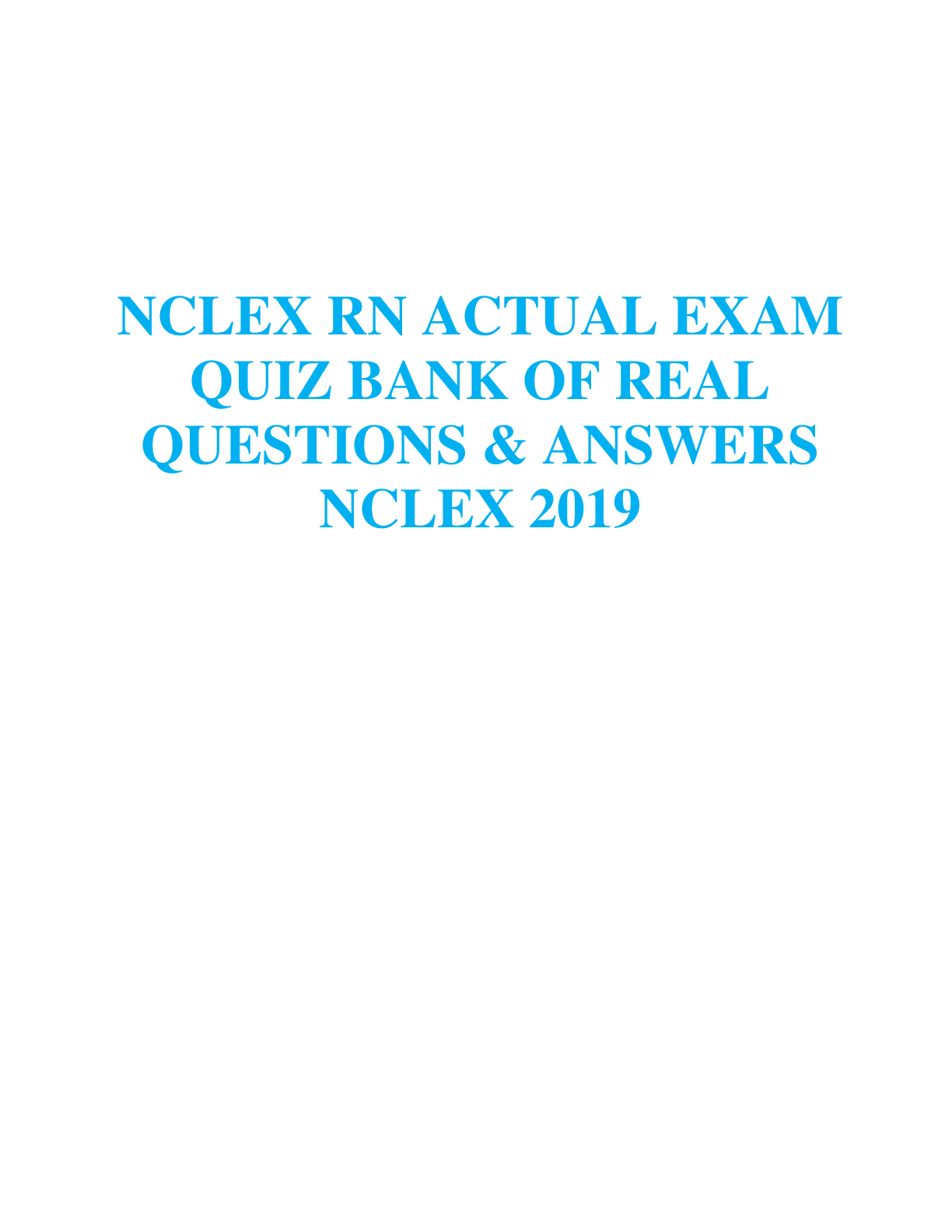
Buy this document to get the full access instantly
Instant Download Access after purchase
Buy NowInstant download
We Accept:

Reviews( 0 )
$19.00
Can't find what you want? Try our AI powered Search
Document information
Connected school, study & course
About the document
Uploaded On
Mar 25, 2021
Number of pages
86
Written in
All
Additional information
This document has been written for:
Uploaded
Mar 25, 2021
Downloads
0
Views
129

 With 850 Questions And Answers Guaranteed 100% Grade A.png)
.png)



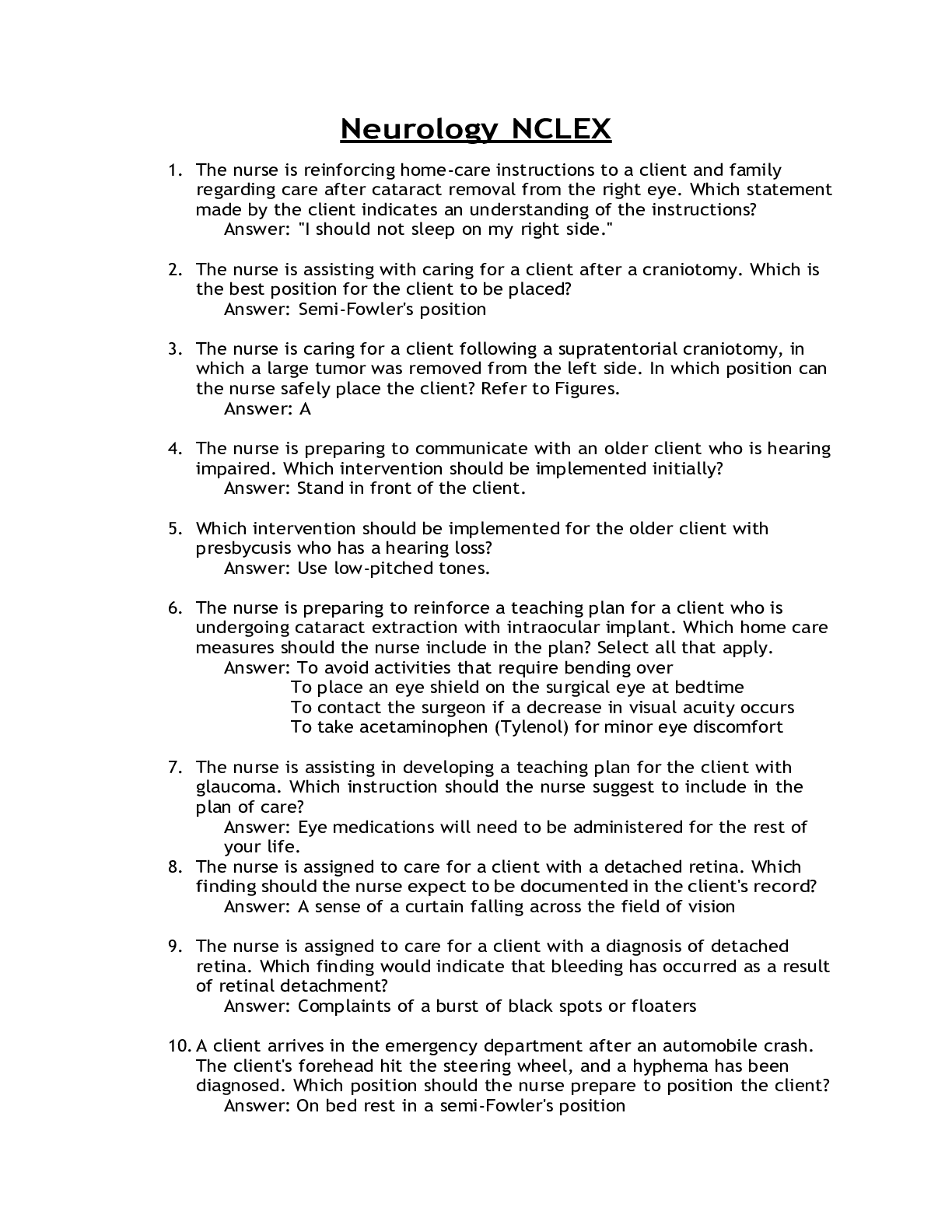

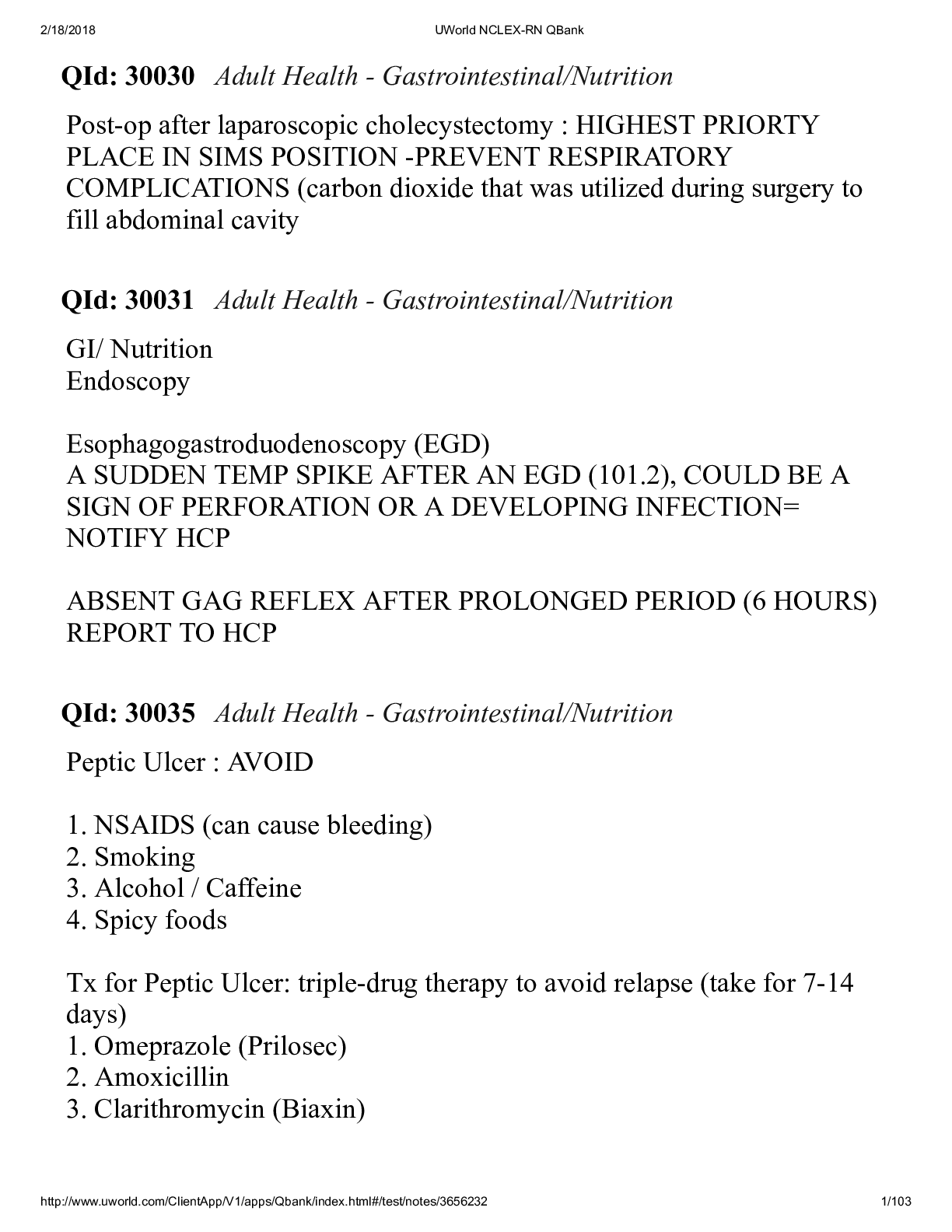


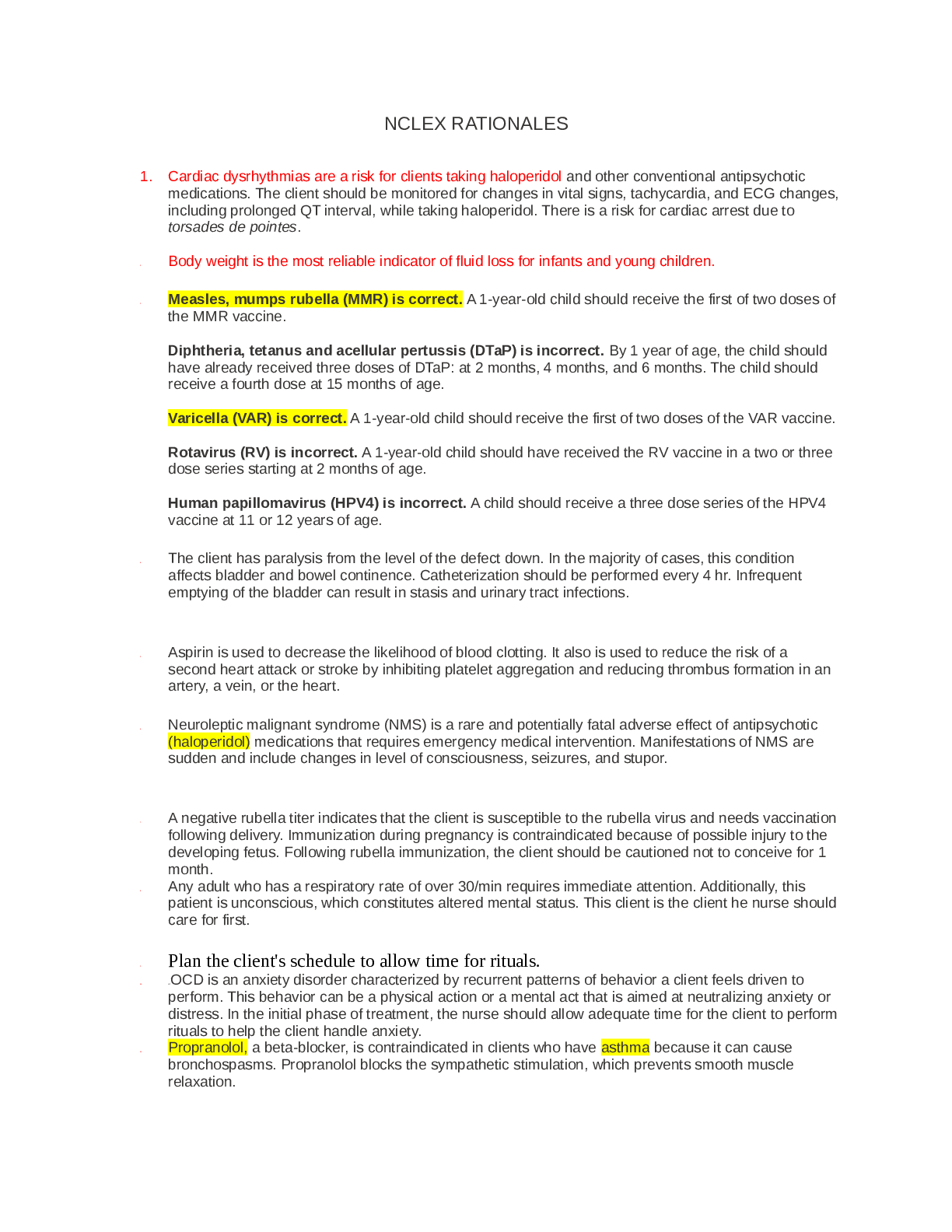

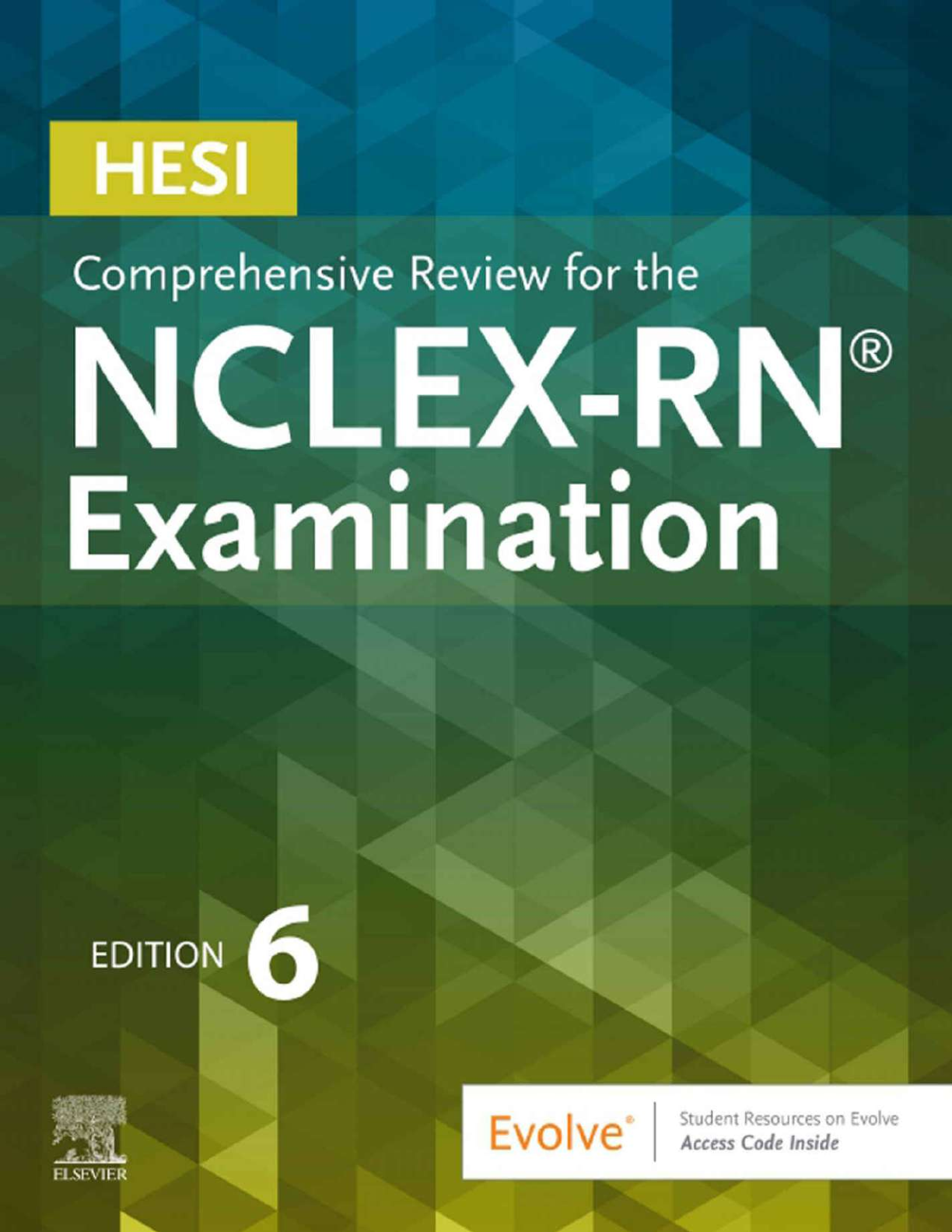

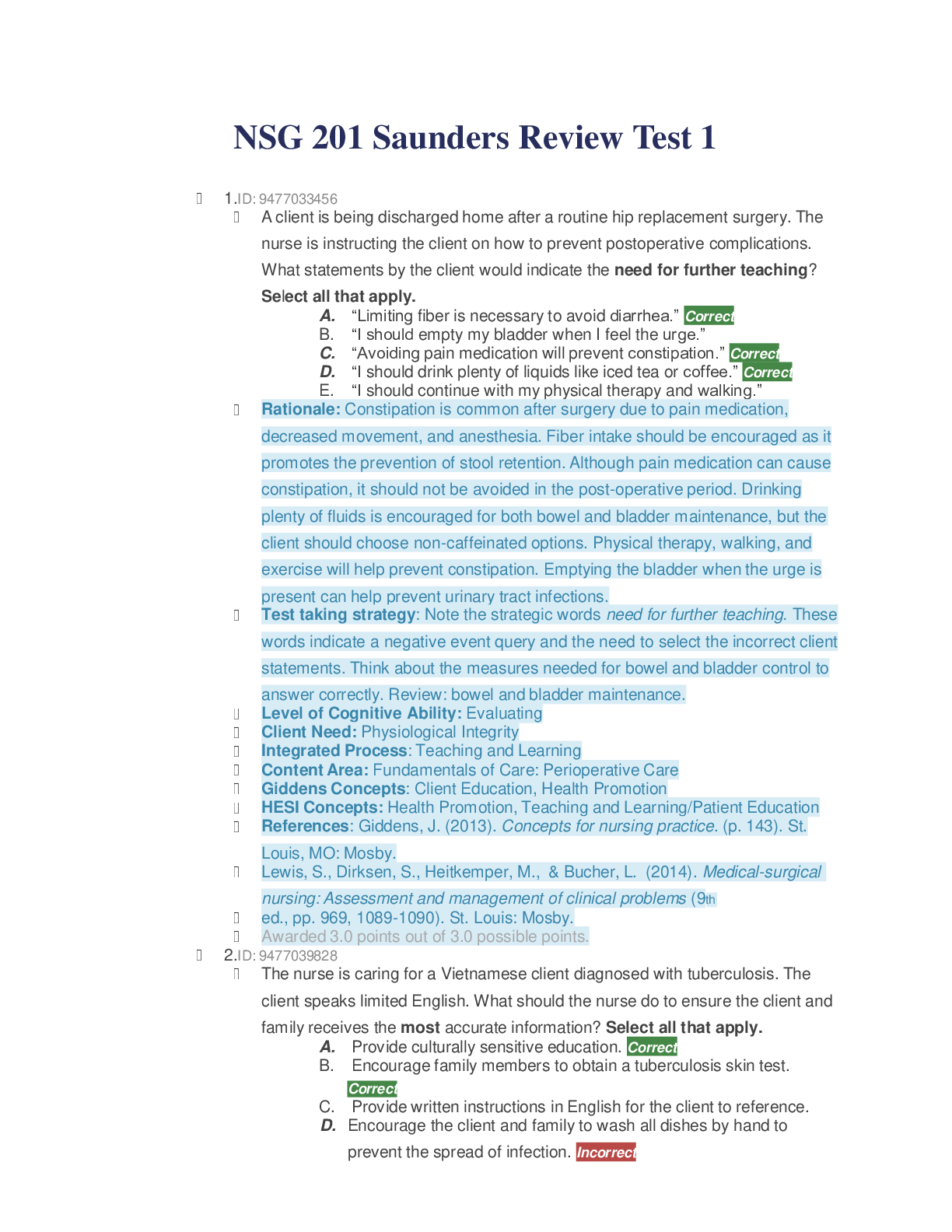
NCLEX.png)

